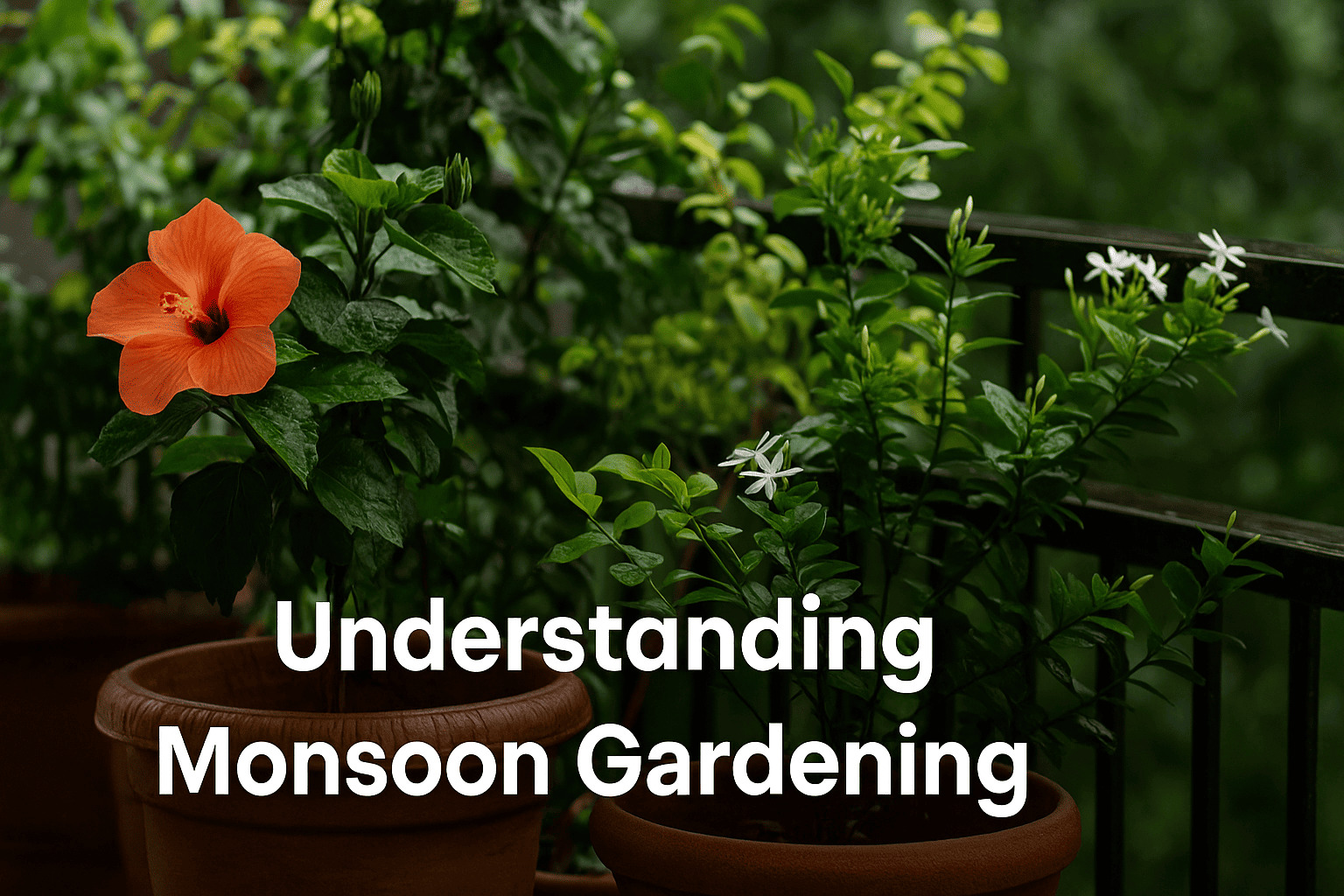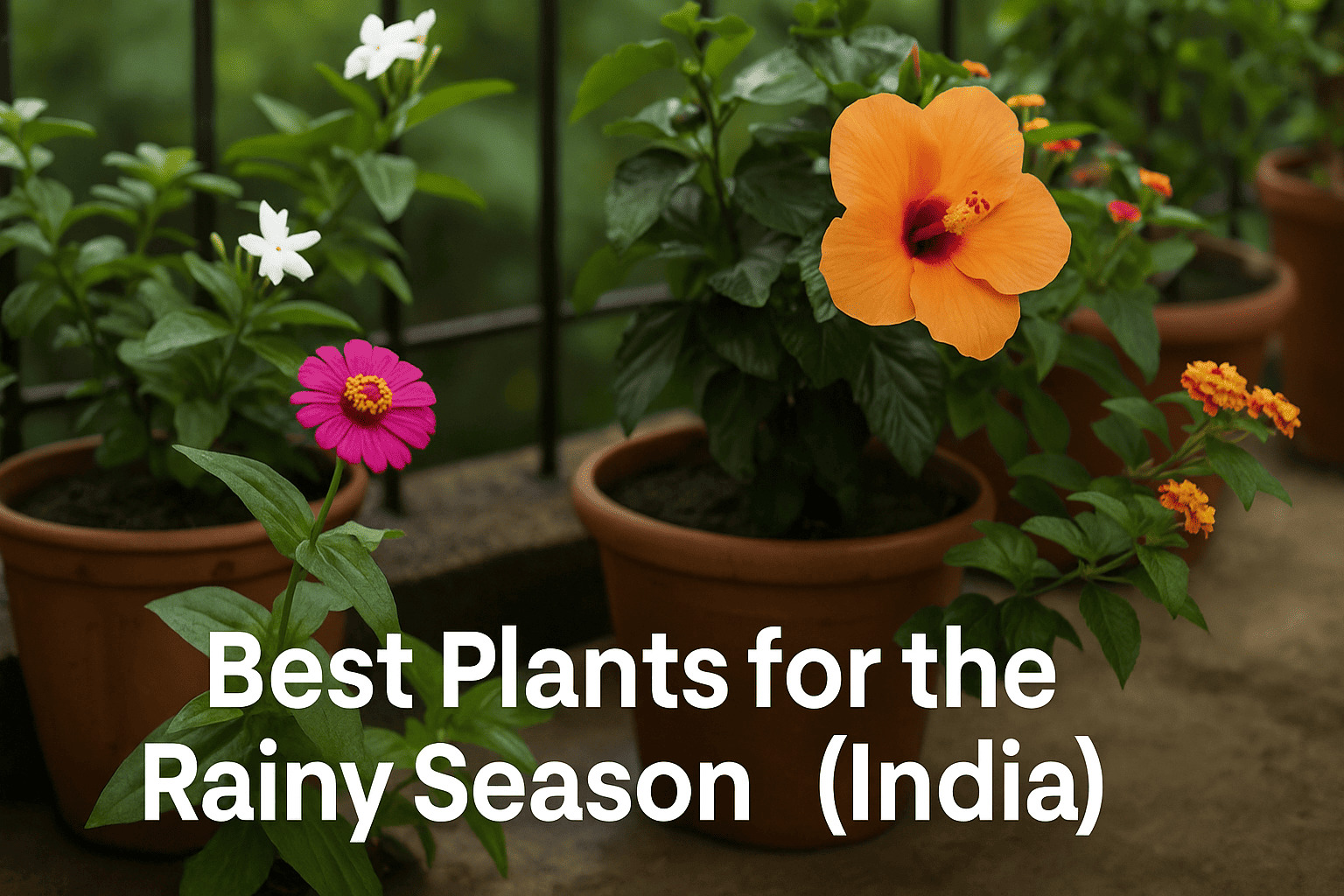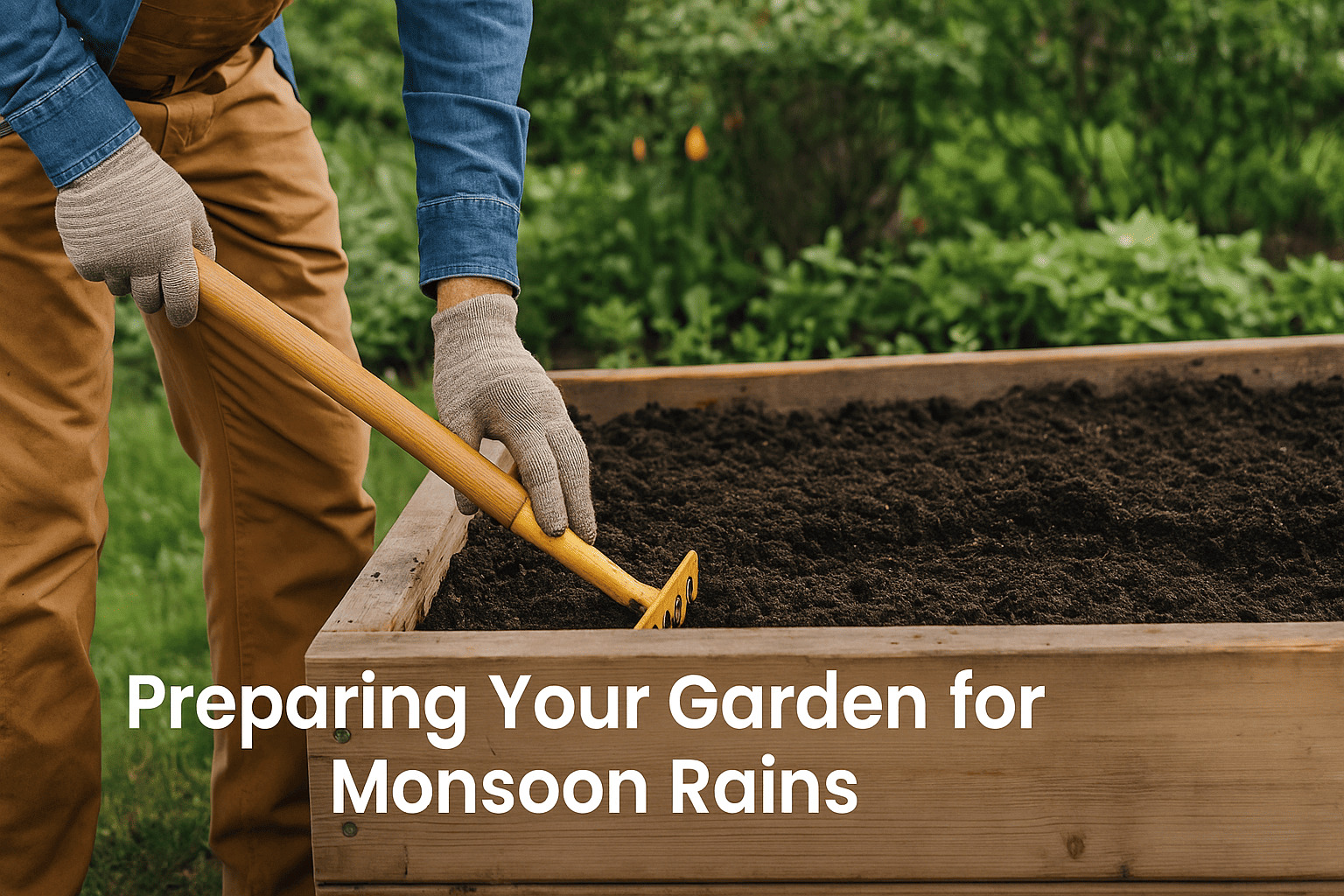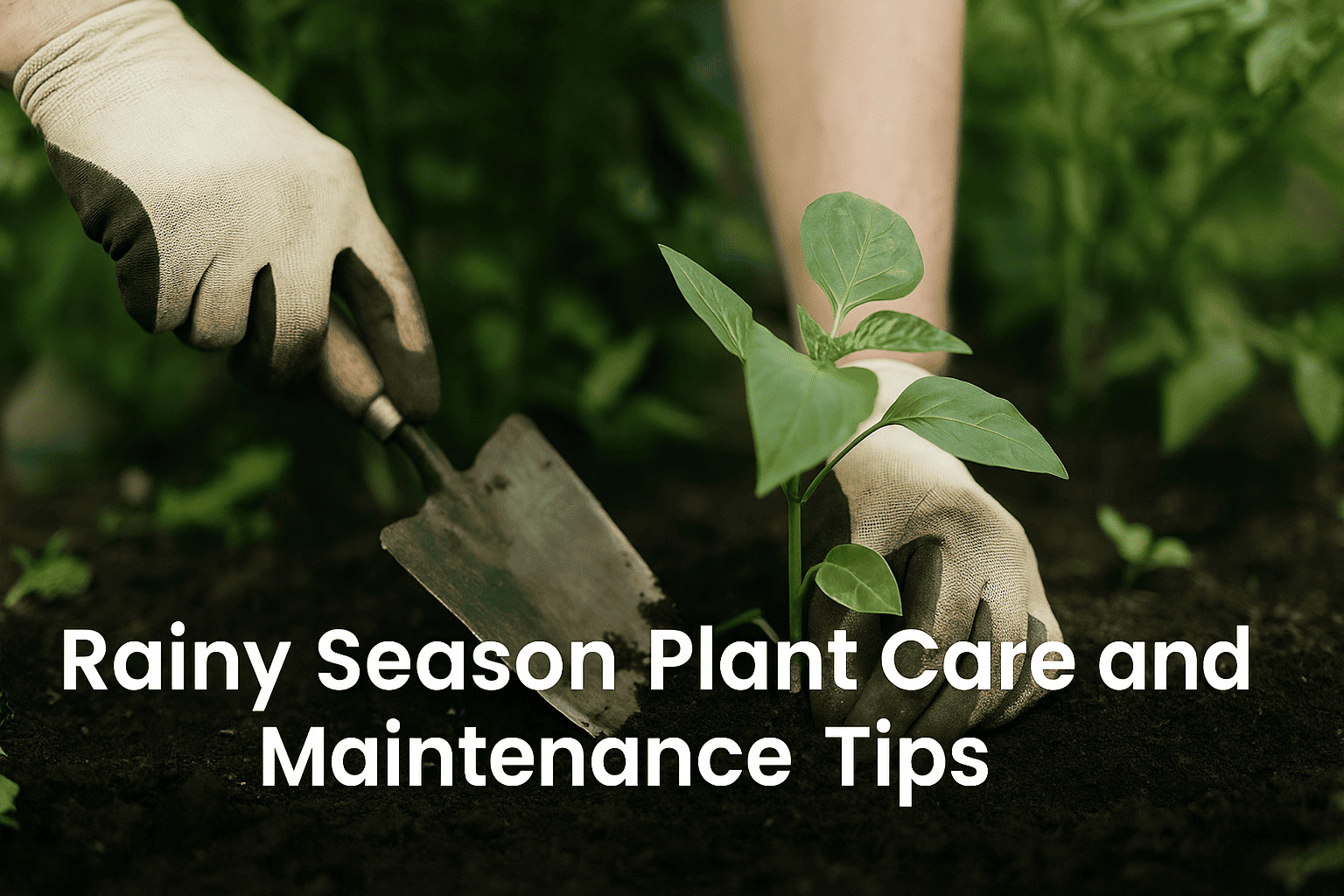.jpg)
Monsoon Gardening is an exciting time for plant lovers in India – the rains breathe new life into gardens and balconies alike.
The rainy season (typically June through September) brings cooler temperatures and abundant moisture, creating ideal growing conditions for many plants.
However, monsoon rainy gardening also presents challenges like waterlogging, fungal diseases, and high winds. In this article, we’ll explore how to make the most of monsoon gardening (even if you’re limited to a balcony or terrace), including choosing the right plants, preparing your soil and containers, and essential rainy season gardening tips.
By understanding the needs of your plants during the rainy season, you can keep your garden lush, healthy, and bursting with life all monsoon long.
Understanding Monsoon Gardening in India

Gardening in the monsoon is unique compared to other seasons. India’s monsoon pours heavy rainfall in short periods – “in the plains of India, it never rains, it pours,” as one expert quips.
This means your garden gets a surplus of water in a short time, which can lead to waterlogging if not managed.
Most plants enjoy “wet feet but dry ankles,” thriving with moist roots as long as their stems and leaves aren’t sitting in water
Good drainage is crucial; the best jungles grow on hill slopes, not in wetlands.
At the same time, the humid atmosphere and cloudy days of monsoon affect sunlight and airflow. Monsoon gardening requires balancing all these factors:
1. Abundant moisture
You’ll rarely need to water manually. In fact, overwatering is a common issue – always check if soil is dry before watering, as too much water can cause fungal infections and yellow leaves.
Observe plants each morning; if leaves are drooping it indicates thirst, otherwise rainfall is likely sufficient.
2. Humidity and reduced sun
Many plants love the humidity and grow faster, but less direct sun can slow others. Keep an eye out for mold or fungus due to persistent dampness.
Ensure some sunlight reaches your plants (placing succulents or cacti in a sunnier spot a few times a week) to prevent rot.
3. Temperature and breeze
Cooler, breezy conditions are a relief after summer. They help pollination and growth, but strong winds can damage tall or weak-stemmed plants.
Plan to provide wind protection or staking if needed during storms.
4. Soil fertility flush
Rain can leach nutrients from soil but also helps release natural nutrients.
Monsoon is a good time to feed plants organic matter since their pores open in the cool, wet conditions, readily absorbing compost or manure.
A light top dressing of compost or vermicompost every few weeks keeps plants nourished without chemical fertilizers that could wash away.
In short, gardening in the rainy season is a balancing act: providing plenty of water but also good drainage, ensuring plants get light but also shelter from downpours.
With the right preparation, your garden will flourish in the monsoon – often growing lusher and greener than at any other time of year.
Also Read
The Ultimate Month-Wise Vegetable Sowing Calendar India (2025): Grow Smarter
Monsoon Secrets: Care Tips For Balcony Plants In Rainy Season
10 Best Plants for the Rainy Season (India)

One key to monsoon gardening success is choosing the right plants. Many rainy season plants thrive in the Indian monsoon’s wet, humid conditions.
Here are some of the best plants for monsoon in India that you can grow in your garden or balcony:
1. Tropical Flowers
Hibiscus and Jasmine are classic monsoon-loving plants.
Hibiscus shrubs burst into bloom with large, trumpet-shaped flowers in rainy weather, giving your garden a winsome tropical look.
Fragrant jasmine vines or shrubs adore the humidity, and their sweet scent combined with the petrichor of rain is pure delight.
Other flowering plants for monsoon include rain lilies (Zephyranthes), which sprout dainty lily blooms after showers, Lotus or water lilies for water gardens, and Mogra (Arabian jasmine) known for thriving in humidity.
2. Lush Foliage & Indoor Greens
Many foliage plants actually prefer the monsoon season. Money plant (Pothos), ferns, Philodendrons, Syngonium, Peace lilies, and Aglaonema (Chinese evergreen) are tropicals that enjoy the warm rains.
These “exotic beauties” often grow under rainforest canopies in nature, so they appreciate monsoon conditions.
You can even move your indoor houseplants outdoors for short periods in gentle rain to refresh their foliage – within days they’ll show new growth and richer green color.
3. Herbs and Edibles
Monsoon is a great time to grow fast-growing, moisture-loving herbs and vegetables. For example, mint, coriander, and basil enjoy the rainy season (just ensure partial shelter for basil to prevent leaf rot).
Leafy greens like spinach and amaranth germinate quickly in damp soil.
Indian gardeners often sow late-summer vegetables as monsoon begins: okra (bhindi), cucumber (kheera), various gourds like bottle gourd (lauki) and bitter gourd (karela), and even brinjal (eggplant) and capsicum.
4. Avoid water-sensitive plants
While many plants love the monsoon, a few do not. For instance, keep succulents and cacti out of the rain – too much water will make them rot.
If you grow succulents, place them under a covered area (or indoors by a window) during peak rains and water sparingly.
Likewise, plants prone to fungal diseases or powdery mildew (e.g. some roses or vegetable varieties) might need extra care or fungicide protection in this season.
By selecting the right monsoon plants – those adapted to high moisture – you set yourself up for success.
A mix of flowering beauties, green foliage, and tasty edibles can all be part of your monsoon garden.
Visit local nurseries or check Urban Plant’s Rainy Season Collection (if available) for plant varieties known to do well in your region’s monsoon.
They often carry rainy season plant kits or recommend hardy native species.
Remember, healthy plants are the best defense against monsoon challenges, so start with varieties that love the rain!
Top 10 Monsoon Vegetables
| Vegetable | Growing Period (North India) |
Growing Period (South India) |
Ideal Temp (°C) | Sowing Method | Container Friendly | Harvest Time |
|---|---|---|---|---|---|---|
| Okra (Bhindi) | June to September | May to August | 25–35°C | Direct in raised beds or grow bags | Yes (minimum 12" deep pots) | 45–60 days |
| Cucumber (Kheera) | June to August | May to July | 22–32°C | Direct or nursery transplant | Yes (with support) | 45–55 days |
| Bitter Gourd (Karela) | June to August | May to July | 24–30°C | Direct sowing on raised mounds | Yes (trellis required) | 50–60 days |
| Bottle Gourd (Lauki) | June to September | May to August | 24–32°C | Direct sowing or trellis setup | Yes (needs support) | 50–60 days |
| Ridge Gourd (Turai) | June to August | May to July | 24–30°C | Direct sowing in ridges | Yes | 45–60 days |
| Sponge Gourd (Gilki) | June to August | May to July | 24–30°C | Direct in moist, loose soil | Yes | 45–55 days |
| Brinjal (Eggplant) | July to September | June to August | 25–32°C | Nursery first, then transplant | Yes (start in nursery) | 60–75 days |
| Spinach (Palak) | July to September | June to August | 18–28°C | Broadcast or row sowing | Yes (shallow wide containers) | 30–40 days |
| Fenugreek (Methi) | July to August | June to July | 20–30°C | Broadcast or row sowing | Yes (shallow trays) | 25–35 days |
| Coriander (Dhaniya) | July to August | June to July | 20–30°C | Broadcast or row sowing | Yes (shallow trays) | 25–30 days |
Best Flowering Plants for Monsoon Season (Balcony and Tooftop-Friendly)
| Plant Name | Benefits | Light Requirement |
|---|---|---|
| Rain Lily | Blooms after rain, very hardy | Partial Sun |
| Hibiscus | Large tropical flowers, fast grower | Full Sun |
| Aparajita (Clitoria) | Climber with vibrant blue blooms | Partial Sun |
| Cosmos | Bright daisy-like blooms, low maintenance | Full Sun |
| Gomphrena | Heat- and rain-tolerant, pollinator-friendly | Full Sun |
Easy-to-Grow Decorative Plants for Rainy Season
- Areca Palm – Adds tropical greenery
- Money Plant – Great in water or soil
- Monstera – Loves monsoon humidity
- Snake Plant – Indoor-safe + rain-tolerant
- ZZ Plant – Low water needs but handles humidity
Preparing Your Garden and Balcony for Monsoon Rains

To make the most of balcony gardening in monsoon, preparation is key.
Whether you have an expansive yard or just a few pots on a high-rise balcony, take these steps before and during the rainy season to protect your plants and capitalize on the rains:
1. Ensure Proper Drainage in Pots & Beds
This is the golden rule of monsoon gardening. Containers must have drainage holes to let excess water escape – a hole at the bottom of the pot is critical because few plants can tolerate sitting in stagnant water.
Use good potting mix that is loose and well-draining (for example, a mix of garden soil with sand, cocopeat, or perlite).
If you’re using Urban Plant’s pots and planters, double-check that the holes are unobstructed.
Pro tip: place a piece of broken pottery or a mesh over the hole before filling soil, so soil doesn’t clog it.
For ground gardens, amend clayey soil with compost and sand to improve percolation
Remember: Waterlogging is a plant killer, so when the forecast says heavy rain, verify that your pots, planters, and garden beds can drain freely.
2. Protect Plants from Heavy Rains
While rainwater is excellent for plants (it’s soft and nitrogen-rich), direct torrential downpour can harm delicate plants. Too much water hitting the soil can cause erosion and nutrient loss.
On balconies, a simple awning or rain shield can diffuse the force of rain. Consider stretching a clear plastic sheet or installing a roll-down bamboo chick that you can use during very heavy rains – it will act like a raincoat for your garden.
Also, avoid pots sitting directly under roof edges where water streams down.
If you notice soil splashing out, add a layer of organic mulch (like coco coir, dry leaves, or wood bark) on top of potting soil.
Mulch buffers the impact of raindrops and prevents soil from splattering or eroding, while also keeping soil moisture even
These breathable fabric covers (often made of fine polyester) let some light and moisture through but shield plants from the brunt of a storm.
3. Secure and Support Your Plants
Monsoon winds and sudden storms can topple containers or snap stems.
In an urban balcony, arrange heavy pots closer to the floor or ground for stability, and use railing hooks or brackets for hanging planters (like Urban Plant’s railing planters) that firmly secure them【72†】.
For tall outdoor plants, insert stakes or trellises to support them. Staking is especially important for top-heavy flowering plants (like dahlias) or climbing veggies – tie the stems gently to bamboo sticks or metal supports so they won’t break in strong wind.
If you have large trees or shrubs, a pre-monsoon pruning is wise: trim long branches so they don’t lash about and remove dead or weak limbs that could fall.
Garden expert Amarjeet Singh Batth notes that trimming back plants keeps them from growing out of control in monsoon and also encourages fresh, healthy growth
Plus, regular pruning of excess foliage improves air circulation, reducing fungal issues.
4. Place Plants Thoughtfully
Rearranging your garden might be necessary for the rainy season.
Move shade-loving or fragile plants to more protected spots. For example, succulents or cacti should be under a covered area so they only get bright light, not direct rain.
Outdoor houseplants (like peace lilies, snake plants, etc.) will enjoy some rain exposure, but don’t leave them waterlogged – put them where they get a shower for an hour or two, then drain off.
Also, rotate your pots every few days during monsoon.
Shifting pots around helps ensure one side isn’t constantly drenched or in deep shade; it also prevents any single spot on your balcony floor from accumulating too much water.
If your balcony tends to collect water, use plant stands to elevate pots above puddles.
Urban Plant sells metal plant stands and pot holders that keep containers off the floor – these are great in monsoon to let water flow away and keep “feet” of pots dry.
5. Prevent Breeding Grounds for Mosquitoes
Monsoons and mosquitoes unfortunately go hand in hand.
As a responsible gardener (especially in cities), make sure you aren’t inadvertently raising mosquitoes in plant saucers or excess water collectors.
Empty drip trays and plates under your pots after each rain.
It’s best to remove saucers entirely during monsoon, or check them daily for standing water. If you have a water storage barrel for rainwater harvesting, keep it covered with a fine mesh.
A clean, dry balcony not only keeps pests away but also reduces fungal growth.
By monsoon-proofing your garden or balcony with these measures, you’ll create a safe haven for your plants during heavy rains.
Taking the time to set up drainage, shelter, and supports means you can sit back and enjoy the showers while your plants drink up and thrive.
Rainy Season Plant Care and Maintenance Tips

Once your garden is prepared, focus on caring for your plants during the rainy season.
Monsoon plant care is a mix of gentle nurturing and vigilant monitoring.
Here are some essential rainy season gardening tips to keep your green friends healthy:
1. Water on an “as needed” basis
During monsoons, you might not need to water at all on rainy days.
Overwatering is a common mistake – remember that the rain often provides plenty of moisture.
Check soil moisture with your finger; water only if the top 1–2 inches of soil are dry or if non-succulent plants show slight wilting.
When you do water (during breaks between rains), do it in the morning if possible and only lightly.
Tip: Rainwater collected in a bucket is great for watering during dry spells – it’s free of chlorine and loved by plants. Just be sure not to let that water stagnate too long (to avoid mosquitoes).
2. Keep foliage clean and pruned
The combination of dust washing off and new growth means your plants will look especially vibrant.
Help them along by removing any yellowed or dead leaves promptly – this debris can foster fungal rot if left on the soil.
After heavy rains, gently shake or tip potted plants to drain excess water from leaf joints.
Some gardeners even wipe the undersides of large leaves occasionally to ensure no pests or fungus are hiding there.
Trimming bushy plants slightly from time to time can improve light penetration and airflow, preventing mildew.
Monsoon is actually the best time to propagate many plants: take those pruned cuttings and try replanting them elsewhere!
You can root rose or hibiscus cuttings, or divide and repot fast growers.
3. Watch for pests and diseases
Warm moisture invites some unwelcome guests – expect more snails, slugs, and fungal diseases like powdery mildew or root rot.
Stay ahead with organic pest control. For example, sprinkle neem cake (neemkhali) in your potting mix or spray a diluted neem oil solution on leaves every 10–15 days.
Neem is a natural fungicide and insect deterrent that’s very effective for rainy-season issues.
You can also use homemade remedies like ginger-garlic spray or a mild soap solution for soft-bodied pests.
If you see snail or slug damage (ragged holes in leaves), place rough gravel or crushed egg shells on top of soil – these pests dislike crawling over sharp textures.
Good garden hygiene is crucial: remove fallen leaves, don't let algae grow in drip trays, and keep some distance between pots for airflow.
If one plant shows fungal infection (spots, mold), isolate it and treat with organic fungicide or a mild copper oxychloride solution.
4. Nourish the soil naturally
Frequent rain can wash out soluble nutrients, so help your plants by replenishing nutrients organically.
During monsoon, favor organic fertilizers over chemical ones – compost, cow manure, vermicompost, or bone meal release nutrients slowly and steadily, and they won’t “burn” plant roots.
In fact, during rains, plants’ pores (stomata) and roots are more receptive, readily absorbing nutrients from compost.
Every 2–3 weeks, add a handful of well-rotted compost or a teaspoon of bone meal to each pot and gently mix it into the topsoil. As a bonus, compost improves soil structure, helping drainage.
Avoid heavy chemical fertilizer applications in monsoon; heavy rain might leach them away before the plant can use them (wasting your effort and possibly polluting runoff).
5. Maintain the lawn and garden landscape
If you have a lawn, monsoon will make grass grow like crazy! Regular mowing (even twice a week if needed) keeps it healthy.
Don’t let grass overgrow and then cut too short – that can leave bald patches.
Instead, frequent trims encourage a thick carpet. Monsoon is also when weeds explode in growth. The trick is to pull weeds early and often.
The good news: wet soil makes weeding easier, as roots come out more readily. Try to remove weeds before they seed.
On the bright side, earthworms will appear in your wet garden soil – don’t panic!
These wriggly creatures are beneficial “soil builders” that aerate and fertilize your garden, so welcome them as free gardeners.
6. Leverage the rain for propagation
Rainy season is an excellent time to start new plants. Many seeds germinate faster in the warm, moist conditions – you can sow quick crops like mustard greens or fenugreek (methi) for microgreens and see them sprout in days.
If you’ve been wanting to try air-layering or cuttings, monsoon humidity boosts success rates for roots forming.
For example, you can take chrysanthemum cuttings during monsoon; gardeners prepare terminal cuttings in sandy rooting mix under shade and have them rooted by mid-July.
Monsoon gardening is as rewarding as it is educational. You’ll learn to read your plants’ needs – a bit of droop meaning they need checking, a flush of mushroom growth telling you your soil is rich (but maybe too damp on top).
Enjoy the experience: there’s nothing like sipping chai on your balcony, watching your monsoon garden soak in the rain. With these care tips, your home garden (no matter how small) will remain a vibrant, green oasis throughout the rainy season.
FAQ– Monsoon & Rainy Season Gardening
What is monsoon gardening and why is it important in India?
Monsoon gardening refers to growing plants that thrive in India’s rainy season, typically from June to September. It takes advantage of natural rainfall, high humidity, and cooler temperatures to grow flowers, vegetables, and herbs with minimal watering. It’s important because monsoon conditions are ideal for fast plant growth and sustainable gardening practices.
Which are the best plants for monsoon gardening in India?
The best monsoon plants in India include hibiscus, jasmine, rain lilies, money plant, ferns, peace lilies, mint, coriander, and vegetables like okra, bitter gourd, and spinach. These plants thrive in moist, humid conditions and are ideal for balcony and terrace gardening during the rainy season.
How do I protect balcony plants during heavy rains in the monsoon?
To protect balcony plants in monsoon, ensure pots have proper drainage holes, use rain shields or awnings to prevent direct water force, elevate pots with stands, and add mulch to prevent soil erosion. Also, stake taller plants to avoid stem breakage due to winds or water weight.
What vegetables grow best in the rainy season at home?
Vegetables that grow best in the rainy season include okra (bhindi), cucumbers, ridge gourd, sponge gourd, brinjal (eggplant), spinach, coriander, and fenugreek. These can be grown in raised beds or containers and thrive in moist, well-drained soil during monsoon.
How to prevent fungal infections in monsoon gardening?
Prevent fungal infections by ensuring good drainage, pruning for airflow, and applying neem oil sprays every 10–15 days. Avoid letting water stagnate in pots or trays, and always remove dead leaves and debris promptly.
Can I grow vegetables in monsoon on a balcony?
Yes, leafy greens like spinach, methi, and coriander grow well in railing planters and small pots.
Conclusion
By following these tips and tricks, monsoon gardening can be a delightful and productive experience.
Your plants will drink up the rains and reward you with lush greenery and blooms.
So gear up with your gardening tools (don’t forget a good pair of boots and an umbrella for yourself!), and enjoy the refreshing ritual of balcony gardening in monsoon.
With the right preparation and care, you’ll have a thriving garden oasis all season long.
Happy monsoon gardening!





